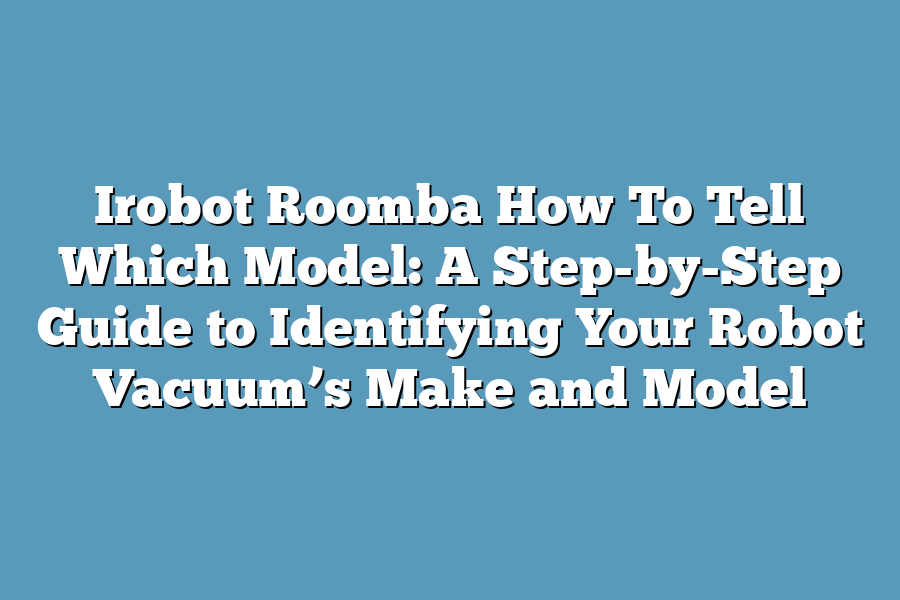To determine which Roomba model you have, check the bottom of the robot for a label or sticker that displays the model number. You can also refer to the user manual or packaging box if you still have it. If all else fails, measure the diameter of the Roomba’s cleaning path and consult online resources, as different models typically have distinct path diameters.
As a long-time enthusiast of iRobot’s innovative robot vacuums, I’ve had the pleasure of getting up close and personal with my trusty Roomba – and the excitement never gets old!
But have you ever found yourself wondering which model you’re actually using?
With so many variations out there, it’s easy to get confused.
That’s why I’m thrilled to share my expertise with you today, as we dive into the ultimate guide on how to identify your iRobot Roomba’s make and model.
In this step-by-step tutorial, we’ll cover three key areas: the base plate, top cover, and D-CIN sensor and charging port.
By following these simple steps, you’ll be able to confidently determine which Roomba model is yours, whether it’s a classic 600 series or one of the newer, more advanced models like the i7.
So, let’s get started!
Whether you’re a seasoned Roomba user or just discovering the joys of robot vacuuming, this guide will help you unlock the secrets of your beloved machine.
Table of Contents
Step 1: Check the Base Plate
Are you tired of wondering which Irobot Roomba model you’ve got?
Well, wonder no more!
In this step-by-step guide, we’ll show you how to identify your robot vacuum’s make and model.
And it all starts with a simple check of the base plate.
You see, each Roomba has its own unique base plate that tells us everything we need to know about our robot friend.
It’s like a secret decoder ring, hidden away from prying eyes (or should I say, prying sensors?).
So, let’s dive in and explore how to read this magical plate!
Identifying the Base Plate
To start, simply locate the base plate on your Roomba.
It’s usually located at the bottom of the robot, near the wheels or the charging dock.
Now, take a good look at it – you’ll see a series of numbers, letters, and symbols etched onto its surface.
Deciphering the Serial Number
The first thing to note is the serial number.
This unique identifier is like a fingerprint for your Roomba.
It’s usually 10-12 digits long and starts with an “S”.
Yep, you read that right – it’s always an “S” followed by more numbers!
Make sure to write this down or take a photo of it so you can refer back to it later.
Model Information
Now, look for the model information.
This is usually printed in smaller text next to the serial number.
You’ll see something like “Roomba 960” or “Roomba i7+” – that’s your Roomba’s model number!
Take note of this too, as it’ll help you get the right software updates and accessories.
Key Actions:
To sum it up, here are the key actions to follow:
- Locate the base plate: Find the base plate on your Roomba and take a good look.
- Read the serial number: Take note of the 10-12 digit serial number starting with an “S”.
- Check the model information: Look for the model number printed next to the serial number.
And that’s it!
By following these simple steps, you’ll be able to identify your Irobot Roomba model in no time.
Stay tuned for our next step – we’ve got even more tips and tricks up our sleeve!
Step 2: Inspect the Top Cover
Ahah, you’re one step closer to unlocking the secrets of your iRobot Roomba!
In this step, we’re going to focus on the top cover – a crucial element that can give away the model number.
So, without further ado, let’s dive in!
Flip-Top vs Snap-On: What’s the Difference?
As you gaze upon your Roomba’s top cover, you might notice it has one of two distinct designs: flip-top or snap-on.
These terms might sound like something out of a sci-fi movie, but trust me, they’re essential for identifying your robot vacuum’s make and model.
Flip-Top Top Covers
On older Roomba models (think pre-2010), you’ll often find flip-top top covers.
These babies have a hinged design that allows you to lift them up and inspect the contents beneath.
If you see a flip-top cover, you’re likely looking at an older model.
Snap-On Top Covers
Fast-forward to newer Roomba models (post-2010), and you’ll encounter snap-on top covers.
These sleek designs simply snap off, revealing the inner workings of your robot vacuum.
Snap-on top covers are often found on more modern Roomba models.
Manufacturer Logos: A Clue to Your Model’s Identity
Now that we’ve covered the different types of top covers, it’s time to get sleuthy!
Take a closer look at your Roomba’s top cover and see if you can spot any manufacturer logos or branding.
These tiny details can give away the model number or provide valuable clues about your robot vacuum’s make.
Key Actions:
- Identify the type of top cover on your Roomba (flip-top or snap-on).
- Check for any manufacturer logos or branding on the top cover.
- Use this information to help narrow down the possible models and identify your Roomba’s make and model.
In our next step, we’ll be diving into the world of serial numbers and stickers.
But for now, you’ve got a solid foundation in identifying the top cover – a crucial piece of the puzzle that will ultimately lead you to your robot vacuum’s secret identity!
Step 3: Examine the D-CIN Sensor and Charging Port: A Clue to Your Robot Vacuum’s True Identity
Now that we’ve taken a closer look at the serial number and model number, it’s time to dig deeper into the world of sensors and charging ports.
Yes, you read that right – sensors and charging ports!
In this step, we’ll explore how to identify these crucial components on different Roomba models.
So, grab your trusty magnifying glass (or smartphone camera) and let’s get started!
The D-CIN Sensor: A Tale of Two Sides
As we discussed earlier, the serial number can give us a hint about our Roomba’s model.
But what if it doesn’t?
Fear not, dear reader!
The D-CIN sensor is here to save the day.
Located on either side of the robot vacuum (usually near the front or back), this sensor is a key identifier for many Roomba models.
Here’s how to spot the D-CIN sensor:
- On older Roomba models like the 500 series, you’ll find it on the left or right side of the device.
- For newer models like the 600 and 700 series, check the top or bottom edge of your Roomba. It might be hiding in plain sight!
- Some Roomba models have a small LED light next to the D-CIN sensor. This can help you confirm its presence.
Charging Port: The Telltale Sign
Now that we’ve found our D-CIN sensor, it’s time to zero in on the charging port.
This might seem like an obvious giveaway, but trust me – some Roomba models have charging ports that are more…
let’s say, “creative” than others.
Here’s what to look for:
- The charging port is usually located near the top or bottom of your Roomba.
- Some models have a recessed area around the charging port, while others might have a flat surface.
- Check if there are any distinguishing features like buttons, lights, or symbols nearby. These can help you narrow down the model.
Putting it all Together: A Recipe for Success
Now that we’ve examined the D-CIN sensor and charging port, take note of any distinctive features or markings.
Combine this with your serial number findings, and you’ll start to piece together the puzzle that is your Roomba’s true identity!
Remember, practice makes perfect!
The more you get familiar with these visual cues, the easier it becomes to identify your robot vacuum’s make and model.
That’s it for Step 3!
In our next section, we’ll dive deeper into the world of aesthetics – but for now, take a breather and pat yourself on the back for a job well done.
Final Thoughts
And there you have it!
Identifying your iRobot Roomba model is now a breeze, thanks to these three simple steps.
By checking the base plate, inspecting the top cover, and examining the D-CIN sensor and charging port, you’ve gained the skills to confidently determine which Roomba model you’re working with.
Whether you’re looking to troubleshoot an issue or simply want to know more about your trusty robot vacuum companion, this guide has empowered you to take control and get the job done.
As someone who’s always been fascinated by the inner workings of these clever devices, I’m excited to see what new discoveries await us in the world of iRobot Roomba technology.
Until next time, happy cleaning with your newly identified Roomba model!


